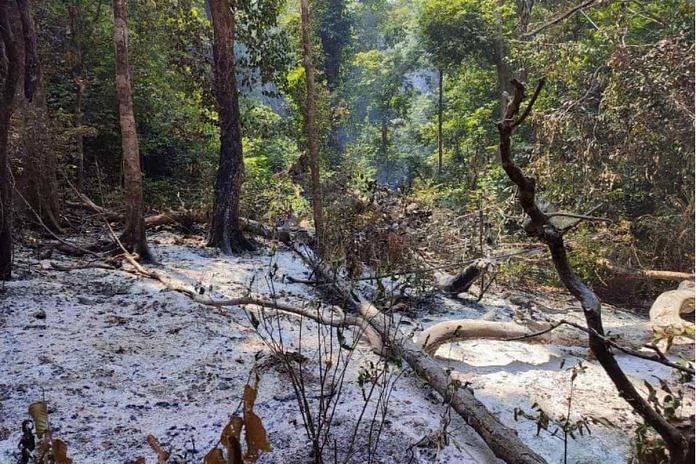Sattari, Goa: On the evening of 10 March, the residents of Kopardem in Goa’s Sattari taluka gathered near the village temple, eyes transfixed on the hills that loomed beyond. Flames licked the sky, striking fear in their hearts.
Many were anxious about the village men and youth who had gone up to the hills with forest rangers to beat back the raging inferno. Others feared their livelihoods from the vast cashew plantations would turn to ash.
For Chaitra Sawant and her husband, this fear came true. This Sunday, they received news that the fire had been doused, but it had destroyed almost their entire cashew plantation. They had been expecting it to fetch them Rs 70,000-80,000 this year.
“We had about 5 acres of plantation on the hills and now only about five or six of our cashew trees remain,” Sawant told ThePrint.
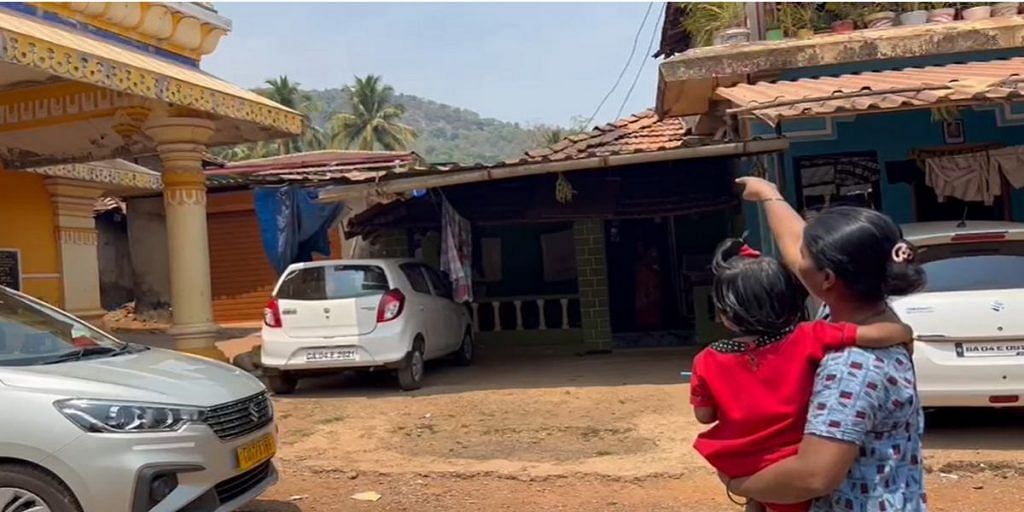
Goa’s hills have been scorched by forest fires since 5 March, when the first blaze was reported close to Satrem village in Mhadei Wildlife Sanctuary. So far, 71 fires have been detected and doused across Mhadei, Netravali, Mollem, and other forests. The state has a forest cover of about 755 square kilometres.
According to a Twitter update from Goa Forest Minister Vishwajit Rane, 14 March was the first day when there was not a single active fire.
Over the previous 10 days, over 400 government officials, forest officers, and local volunteers had camped in the jungles to extinguish the flames, with the Indian Navy and Air Force also deploying helicopters to assist in this effort.
Rane said Wednesday that the Goa government has deployed more than 350 personnel to ensure there are no fresh fires.
The blazes seen this month have been unprecedented, say villagers, forest officials, and activists alike. While localised minor fires are not uncommon, they say they have never seen entire swathes of forests burning before.
As the ash settles, authorities are yet to pinpoint the cause of the fires, but they have put forth some theories, ranging from human factors to the effects of unusually hot and windy weather conditions.
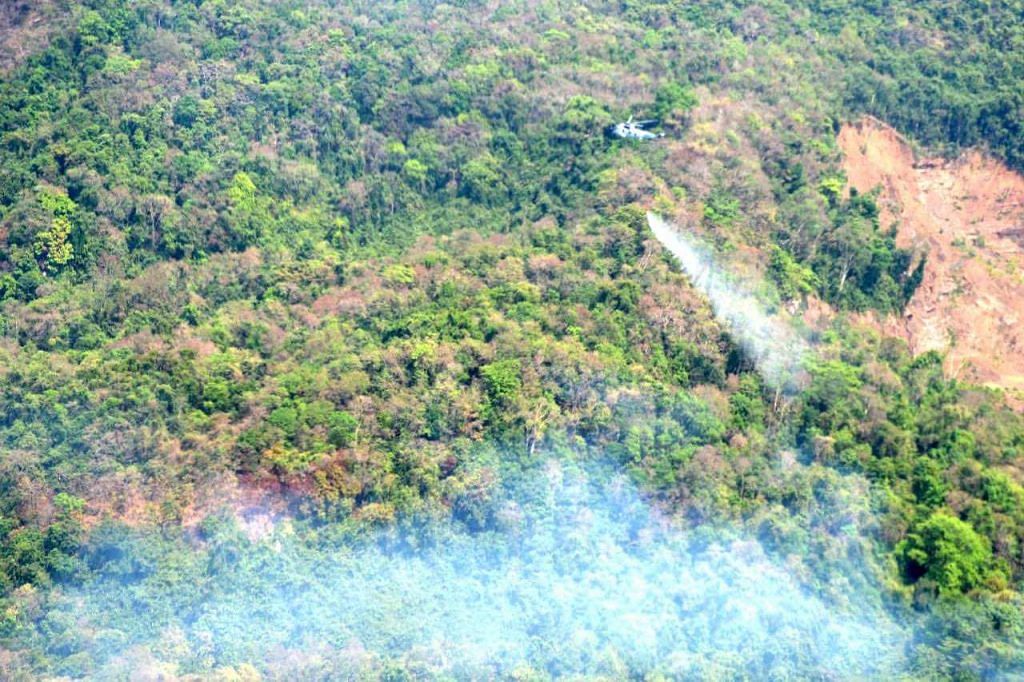
Goa Chief Minister Pramod Sawant and Forest Minister Rane, who hails from Valpoi in Sattari, have gone on record to say that the fires were not accidental, but “manmade”.
Goa government officials and the police claim local cashew farmers often start constrained fires to clear their orchards of weeds and dead crops, but this year, a rise in temperature, coupled with wind and humidity factors, fuelled the flames.
Cashew farmers living close to the hills, however, say that they have never been irresponsible with these localised fires, and it is hard to believe these could have caused such large conflagrations.
According to Goa police, across all the 71 incidents, there have been only two police cases and one arrest — that of a local from Kupordem village who has a cashew orchard himself. His fellow villagers told ThePrint that he is a teacher and they do not believe he committed an act of deliberate arson.
“Cashew farmers are known to start localised fires, but this is the first time things have gone out of hand. Right now the focus is on controlling the fires and ensuring they don’t recur. But, once things settle down, we will send a special team to the ground to investigate the exact cause of the fires,” Nidhin Valsan, North Goa superintendent of police (SP), told ThePrint.
Meanwhile, some environmental activists have raised questions about the extent of the biodiversity damage as well as the concentration of fires in the Mhadei Wildlife Sanctuary region, where there has been a tussle over a proposed tiger reserve.
Also read: 10-fold rise in intense forest fires in India from 2000 to 2019, study points to climate change
‘Surface fires not uncommon’
According to a satellite-based survey of forest fires by the Forest Survey of India (FSI), there has been a 115 per cent rise in the number of forest fires across the country in the first 12 days of March 2023, as compared to the same period a year ago, mainly due to increased temperatures.
The data says the number of forest fires from 1-12 March this year was 42,799 as compared with 19,929 last year.
Speaking to ThePrint, Milind Karkhanis, a retired Goa forest officer, said there are two types of forest fires. The first kind is crown or midstorey fires that are caused by the friction of trees. The second type is surface fires, which are kindled on the ground.
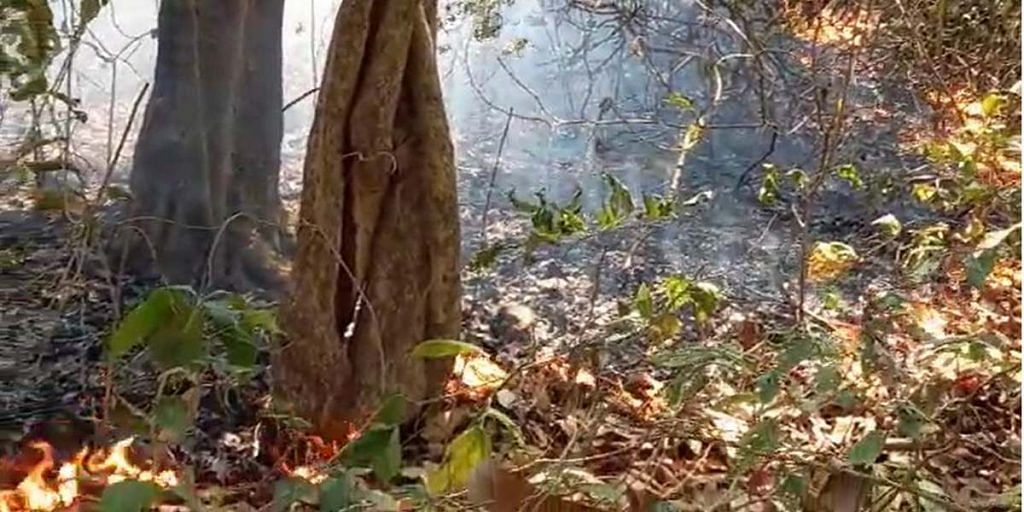
In his vast experience of working with the Goa forest department, Karkhanis has seen surface fires being kindled due to multiple minor reasons— someone smoking a beedi and tossing it on the ground while it is still lit, cashew farmers setting dead crops and weeds on fire, goat herds burning land to help grass rejuvenate.
“Goa does not have the trees that can cause crown fires, but the state has seen many instances of surface fires. These are very easy to extinguish by beating them with brushwood branches, provided they are detected before the fire leaves the surface,” Karkhanis said.
“The problem this time is it seems like the basics of early detection of fires were not taken care of. I have never seen such numbers in the past,” he said.
Goa-based environmentalist Rajendra Kerkar, who has been working for the conservation of the Western Ghats, also alleged at certain “lax” practices.
He told ThePrint that while forest officials have stepped up their vigil after the fire outbreaks, he has earlier observed shortfalls in guarding entry points and patrolling.
“The leaf litter is not cleared, and due to this any surface fire spreads fast. I had brought all this to the attention of forest officials just a fortnight ago, but nothing was done,” Kerkar claimed.
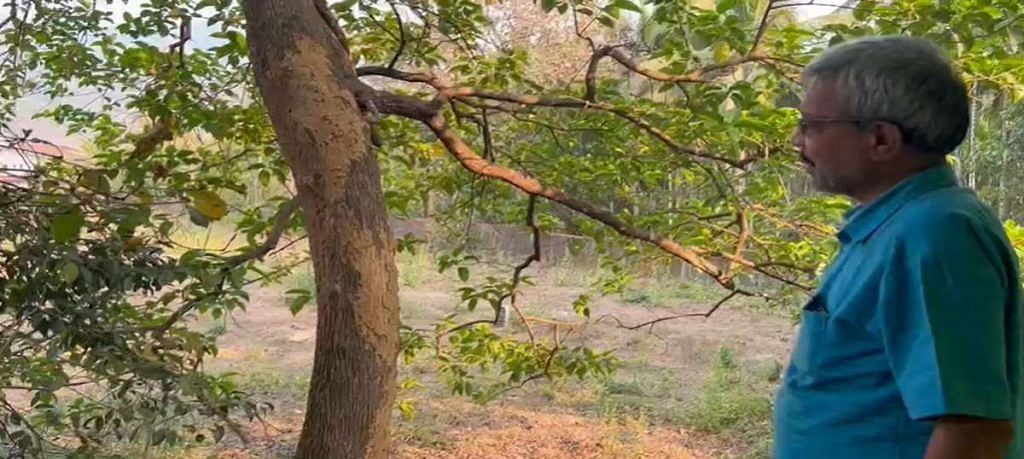
A statement issued by the Union environment ministry on 11 March, too, said that the blazes were mostly “surface fires” in patches of deciduous forests.
“The expansion and spread of the surface fire are dictated by the load of surface fuel and area harbours. At places, dead trees, fallen logs have added on to the intensity of the fire,” the press note said.
Tiger factor, questions over biodiversity damage
Conservationist Kerkar lives amid the lush greenery of Sattari’s Keri village at the foot of the Mhadei Wildlife Sanctuary. “It is a beautiful part of Goa and I am trying my best to preserve it,” he said.
Kerkar voiced concerns that many fires were reported in the same area where environmental activists have been advocating for the government to declare a tiger sanctuary. The proposal is over 20 years old, but became louder after the death of a tigress and her three cubs here in 2020, allegedly due to poaching.
This area is in the periphery of the Vagheri hills, which, in fact, are named after tigers—’vagh‘ in Konkani and Marathi.
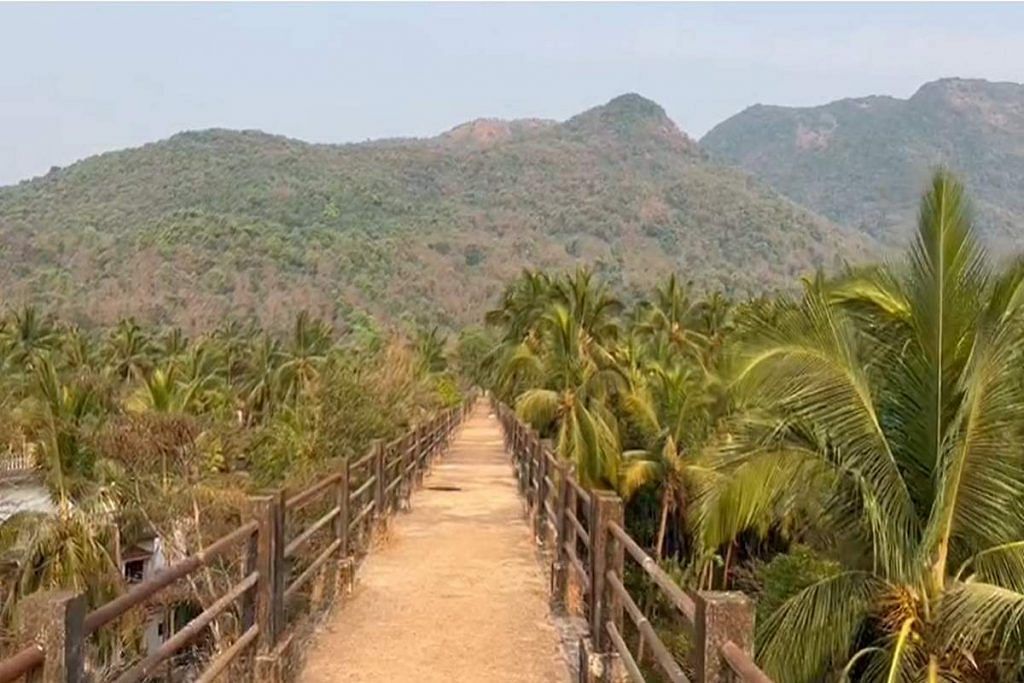
Last April, however, Forest Minister Rane, who is from Valpoi in Sattari, said he did not support the idea of a tiger sanctuary, controversially claiming that there are no resident tigers in Goa.
There is also reported to be considerable local resistance to the idea of a tiger reserve here due to the impact it could have on mining and other development activities.
Another issue raised by environmentalists is around the extent of fire damage to the area’s biodiversity.
Karkhanis, an expert on forest conservation, said that approximately 16-20 hectares of forests have been destroyed in the fires, going by the unofficial estimates of serving and former forest officers in Goa.
This, he said, would have a devastating impact on the region’s biodiversity, including birds, reptiles, butterflies, animals, medicinal plants, and more.
The cost of the damage caused by these fires is calculated by forest officials in accordance with guidelines established by a committee appointed by the Supreme Court.
In a 2021 report, this committee said that the cost of a tree is Rs 74,500 multiplied by the age of the tree.
According to Karkhanis, there are at least 200 trees in each hectare, and assuming an average age of 25, the valuation of damage to 16 hectares of forests is approximately Rs 596 crore.
The earlier cited statement issued by the Union environment ministry, however, claimed that there have been “no major losses” of flora and fauna.
Also read: Is India’s Project Tiger going off script? Big cat deaths from Corbett to Pench to Kanha
Blame game with cashew farmers
While the Union environment ministry statement, cited earlier, laid some blame for the fires on “slash-and-burn” techniques used by farmers in grasslands and cashew farms, locals in Sattari said they did not use this method.
In this taluka, from where the fires first started, 10,852.1 hectares are under cashew plantations, according to 2021-22 data from the zonal agricultural office.
Most of this land is in the hills, and while about 60 per cent is owned by farmers, the remaining 40 per cent is government land that has been encroached upon and cultivated by generations of farmers, claimed an official in the zonal agricultural office.
Overall, the taluka’s cashew production for the 2021-22 season was an impressive 5,801.53 tonnes.
Cashew farmers from Sattari ThePrint spoke to said they routinely clear their orchards of weeds and dead trees every few months, usually by hiring manual labour.
“There are some farmers who don’t want to spend the money in hiring labour so they bring all the dead trees and weeds closer together, create an agni resha (a fire line to contain the fire), and then set it on fire,” said Reena Sawant, whose family owns a cashew orchard on the hills at Valpoi in Sattari taluka.
She added, however, that people are not “negligent” even when they do light fires.
“We all have our orchards next to each other and those lighting a fire wouldn’t want to damage their own crop, as well as that of their neighbours. They usually stay there till the fire is completely out,” she said.
Eknath Sawant, the only person arrested so far for kindling a forest fire, was allegedly trying to set such a contained fire in his orchard, an official from the Valpoi Police station told ThePrint.
“When he realised that the fire was getting out of hand, it appears that he informed the forest officials about it and they filed a complaint against him with us on 12 March,” the official said.
“The wind was very strong here the past few days. That might have been a cause for the fire to spread,” he added.
Sawant has been booked under Section 435 of the Indian Penal Code, which pertains to committing mischief by fire or any explosive substance intending to cause or knowing that it will cause damage to property. He has also been booked under Section 30 of the Wildlife Protection Act, which deals with kindling a fire in a sanctuary.
According to information from the zonal agriculture office in Sattari, there are officially 12 cases of cashew farmers having suffered crop damage due to the forest fires and who have applied for compensation. Informal inquiries, though, suggest that the number is closer to at least 20.
Vishwanath Gavas, zonal agriculture officer of Sattari who himself owns a cashew orchard in the taluka, told ThePrint that very few people use the slash-and-burn technique now, fearing damage to each other’s cashew properties.
“There are about 70 villages here and we live like a small community. If by chance the fire burns the neighbouring orchard’s crop, everyone will know who has kindled the fire. The local panchayat will make him answerable. No one wants to go through all of that. If at all anybody burns the roughage, it is only after 15 May when the weather cools a bit and there are high chances of rain,” Gavas said.
Besides, he added, the cashew crop is a matter of pride for Sattari’s farmers and the ups and downs of their lives are dependent on the annual bounty the cashews fetch them.
“If it is a good crop, people are happy. They consider it auspicious to plan weddings or any good occasions in the family,” Gavas said. “The sentiment is very strong, and no one will intentionally harm this sentiment.”
(Edited by Asavari Singh)
Also read: Onion prices, forest land rights, loan waivers — 10,000 farmers march to Mumbai for ‘unmet demands’


